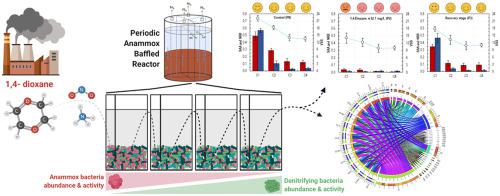Journal of Hazardous Materials ( IF 12.2 ) Pub Date : 2021-02-25 , DOI: 10.1016/j.jhazmat.2021.125533 Sherif Ismail , Ahmed Elreedy , Manabu Fujii , Shou-Qing Ni , Ahmed Tawfik , Mohamed Elsamadony

|
Long-term exposure of anammox process to 1,4-dioxane was investigated using periodic anammox baffled reactor (PABR) under different 1,4-dioxane concentrations. The results generally indicated that PABR (composed of 4 compartments) has robust resistance to 10 mg-dioxane/L. The 1st compartment acted as a shield to protect subsequent compartments from 1,4-dioxane toxicity through secretion of high extracellular polymeric substance (EPS) of 152.9 mg/gVSS at 10 mg-dioxane/L. However, increasing 1,4-dioxane to 50 mg/L significantly inhibited anammox bacteria; e.g., ~93% of total nitrogen removal was lost within 14 days. The inhibition of anammox process at this dosage was most likely due to bacterial cell lysis, resulting in the decrease of EPS secretion and specific anammox activity (SAA) to 105.9 mg/gVSS and 0.04 mg N/gVSS/h, respectively, in the 1st compartment. However, anammox bacteria were successfully self-recovered within 41 days after the cease of 1,4-dioxane exposure. The identification of microbial compositions further emphasized the negative impacts of 1,4-dioxane on abundance of C. Brocadia among samples. Furthermore, the development of genus Planococcus in the 1st compartment, where removal of 1,4-dioxane was consistently observed, highlights its potential role as anoxic 1,4-dioxane degrader. Overall, long-term exposure to 1,4-dioxane should be controlled not exceeding 10 mg/L for a successful application.
中文翻译:

1,4-二恶烷长期暴露和恢复潜能下厌氧菌团的疲劳:N-动力学和微生物动力学
使用周期性厌氧折流板折流板反应器(PABR)在不同的1,4-二恶烷浓度下研究了厌氧氨气工艺长期暴露于1,4-二氧六环的情况。结果通常表明,PABR(由4个隔室组成)对10 mg-二恶烷/ L具有很强的抵抗力。1个ST充当屏蔽隔室通过高胞外聚合物物质的分泌,以保护从1,4-二恶烷毒性随后的隔室的152.9(EPS) 在10毫克二恶烷/ L毫克/ gVSS量。但是,将1,4-二恶烷增加到50 mg / L显着抑制厌氧氨氧化菌;例如,在14天内损失了约93%的总氮去除量。在此剂量下,厌氧氨氧化过程的抑制作用最可能是由于细菌细胞裂解所致,导致1的EPS分泌和特定的厌氧氨氧化活性(SAA)分别降低至105.9 mg / gVSS和0.04 mg N / gVSS / h。圣车厢。然而,厌氧细菌在1,4-二恶烷接触停止后的41天内成功地自我恢复。微生物成分的鉴定进一步强调了1,4-二恶烷对样品中布氏梭菌含量的负面影响。此外,属发展游动球菌在1日隔室中始终观察到1,4-二恶烷的去除,突出显示了其作为缺氧的1,4-二恶烷降解剂的潜在作用。总体而言, 为成功应用,应控制长期暴露于1,4-二恶烷的浓度不超过10 mg / L。











































 京公网安备 11010802027423号
京公网安备 11010802027423号